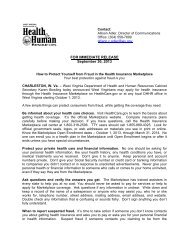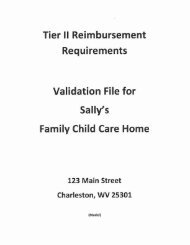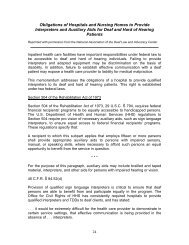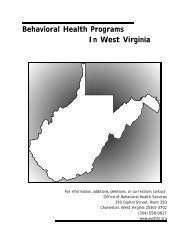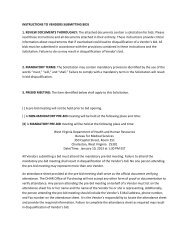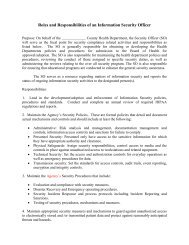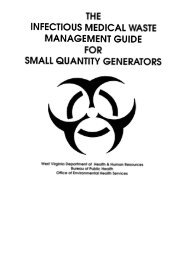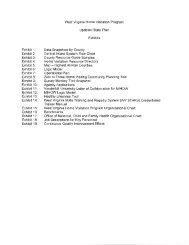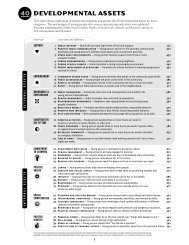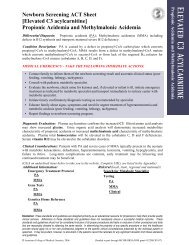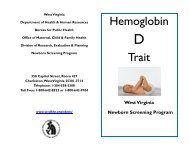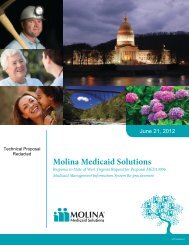Dear Colleague Letter - Centers for Disease Control and Prevention
Dear Colleague Letter - Centers for Disease Control and Prevention
Dear Colleague Letter - Centers for Disease Control and Prevention
Create successful ePaper yourself
Turn your PDF publications into a flip-book with our unique Google optimized e-Paper software.
January 22, 2010<strong>Dear</strong> <strong>Colleague</strong>,This annual <strong>Dear</strong> <strong>Colleague</strong> letter highlights 2009 activities involving the Division of STD <strong>Prevention</strong>(DSTDP) <strong>and</strong> our external STD prevention colleagues <strong>and</strong> looks <strong>for</strong>ward to issues <strong>and</strong> activities to beaddressed in 2010. We welcome your comments to ensure that this annual letter remains helpful to you.DSTDP Strategic Planning <strong>and</strong> Priority ActivitiesIn 2009, DSTDP used its five-year Strategic Plan to guide DSTDP’s decision making, human <strong>and</strong>financial resource allocation, <strong>and</strong> programmatic direction. DSTDP focused on the following threegoals as top priorities <strong>for</strong> division activity in 2009 – 2010:● Prevent STI-related infertility● Reduce STI-related health disparities across <strong>and</strong> within communities <strong>and</strong> populations● Strengthen STD prevention capacity <strong>and</strong> infrastructureHighlights of 2009 progress in these goals include:• Preventing STI-related Infertility■ Continued development of the National Chlamydia Coalition (NCC), in collaboration with thePartnership <strong>for</strong> <strong>Prevention</strong>.− NCC membership grew to 42 national organizations <strong>and</strong> developed a variety of resourcesincluding a new website, a regular e-newsletter, clinical resources, <strong>and</strong> patient educationmaterials including Why Screen <strong>for</strong> Chlamydia? An Implementation Guide <strong>for</strong> HealthcareProviders.− NCC <strong>and</strong> its member organizations successfully recommended that the National Committee <strong>for</strong>Quality Assurance (NCQA) include the Chlamydia screening Healthcare Effectiveness Data<strong>and</strong> In<strong>for</strong>mation Set (HEDIS) measure in the 2010 NCQA health plan accreditation score <strong>for</strong>commercial <strong>and</strong> Medicaid plans, effective July 2010.■ Expansion of the number of jurisdictions in which Expedited Partner Therapy (EPT) is clearlypermissible to 20 states <strong>and</strong> Baltimore as compared with 10 states in 2006. Details <strong>and</strong> links tostate resources are on the CDC EPT web pages.■ Collaboration with the Maternal <strong>and</strong> Child Health Bureau at HRSA to work with stateadolescent health coordinators to increase Chlamydia awareness among providers <strong>and</strong> thepublic.• Reducing STI-related Health Disparities■ Launched a new interactive STD Health Disparities website.■ Provided STD technical assistance to National Action Network’s “I Choose Life” campaign <strong>for</strong>African-American communities in the southeastern U.S.■ Partnered with Indian Health Service <strong>and</strong> National Coalition of STD Directors (NCSD) todevelop Native STAND (Students Together Against Negative Decisions) training curriculum<strong>for</strong> peer educators to promote health decision-making among Native youth.• Strengthening STD <strong>Prevention</strong> Capacity <strong>and</strong> Infrastructure■ CDC’s National Network of STD/HIV <strong>Prevention</strong> Training <strong>Centers</strong> (NNPTC) collaboratedwith NCSD, state <strong>and</strong> local STD programs, <strong>and</strong> other STD prevention training partners <strong>and</strong>stakeholders to pilot a three-day STD Program Management Course <strong>for</strong> new STD ProgramManagers, now being implemented in each NNPTC region.■ Exp<strong>and</strong>ed the STD Surveillance Network (SSuN) to 40 STD clinics in 12 geographic areascollaborating to monitor trends in STDs <strong>and</strong> related behaviors, allowing broad <strong>and</strong> flexiblecapacity <strong>for</strong> many STD clinic <strong>and</strong> population-based surveillance activities.
DSTDP Leadership <strong>and</strong> AwardsLeadership changes <strong>and</strong> awards received during 2009:● Russell Cantrell was named Deputy Branch Chief <strong>for</strong> the Laboratory, Reference <strong>and</strong> ResearchBranch.● Norman Hayes was named Special Assistant <strong>for</strong> Unit Operations in the Syphilis Elimination <strong>and</strong>STD Disparities Unit.● Tom Gift won the 2009 Kaafee Billah Memorial Award <strong>for</strong> the article “The Program Cost <strong>and</strong>Cost-Effectiveness of Screening Men <strong>for</strong> Chlamydia to Prevent Pelvic inflammatory <strong>Disease</strong> inWomen” published in Sexually Transmitted <strong>Disease</strong>s, 2008.● Lauri Markowitz won the PHS Distinguished Service Medal <strong>for</strong> outst<strong>and</strong>ing national leadershipin vaccine preventable diseases research <strong>and</strong> program implementation.● The CDC Global Perinatal Integration Working Group received the NCHHSTP Director’sRecognition Award. Mary Kamb, Tasneem Malik, Jennifer Mark, Lori Newman, Bruce Furness<strong>and</strong> Lisa Steele represent DSTDP on the group, co-chaired by Mary Kamb <strong>and</strong> Tasneem Malik.● Rachel Kachur received the Excellence in Innovation Award from NCHHSTP <strong>for</strong> her work onthe NCSD Internet guidelines.● Kim Honer received NCHHSTP’s Outst<strong>and</strong>ing Field Supervisor Award (Domestic) <strong>for</strong>exceptional leadership to the Ft. Lauderdale STD Program.● John Heath, Steve Rubin, Paulette Jackson, <strong>and</strong> Phil Powers, senior leaders of our Field Staff,each with more than 30 years of STD prevention experience, retired in 2009.● Similar to the response across CDC <strong>and</strong> state/local public health departments, 107 DSTDP staffplayed key leadership roles during details in responding to the H1N1 p<strong>and</strong>emic.Consultations/MeetingsConsultations allowed engagement with colleagues on a variety of important STD prevention topics:● The Senior Public Health Advisor <strong>and</strong> Field Staff Advisory Committee meeting (January),provided an opportunity <strong>for</strong> field <strong>and</strong> HQ staff to focus on operationalizing program collaboration<strong>and</strong> service integration <strong>and</strong> implementing partner service recommendations.● Laboratory Guidelines Consultation (January) reviewed evidence to revise guidelines <strong>for</strong>laboratory diagnosis of gonorrhea <strong>and</strong> chlamydial infection <strong>and</strong> develop guidelines <strong>for</strong> syphilis;the meeting report is published on the Association of Public Health Laboratories website.● NCHHSTP’s Corrections <strong>and</strong> Public Health Consultation (March) was held to review evidence<strong>and</strong> develop recommendations to promote STD screening in correctional settings.● STD Treatment Guidelines Consultation (April) brought together experts to weigh evidence <strong>and</strong>develop recommendations to update the 2006 STD Treatment Guidelines.● Health Disparities Stakeholders’ Consultations, focused on African-American men (April) <strong>and</strong>MSM (August), engaged community leaders, state <strong>and</strong> local health care providers, the faithcommunity, <strong>and</strong> other federal agencies to in<strong>for</strong>m strategies to reduce STD health disparities.● Regional Gonorrhea <strong>Control</strong> Meetings (May-December) with STD directors, epidemiologists,<strong>and</strong> other program leaders provided opportunities to review epidemiologic trends, challenges, <strong>and</strong>effective interventions <strong>and</strong> develop action plans to enhance GC prevention.● The National Association of Community Health <strong>Centers</strong> (June) brought together healthdepartments <strong>and</strong> health centers in the Southeast to identify barriers that hinder collaboration inSTD screening <strong>and</strong> treatment.● Preventing STDs, HIV <strong>and</strong> Teen Pregnancy: Reducing Health Disparities workshop (July),held in collaboration with the Council of State Governments, brought together 35 state-levelelected officials from 16 southern states <strong>and</strong> Puerto Rico to provide in<strong>for</strong>mation on policies <strong>and</strong>programs that work to reduce disparities.● Cephalosporin-resistant Neisseria gonorrhoeae National Response Consultation (September)initiated the <strong>for</strong>mulation of a comprehensive national <strong>and</strong> state-level public health plan to respondto the threat of the emergence of Cephalosporin-resistant gonorrhea in the U.S.
New ToolsNew tools to enhance STD prevention program delivery were developed in 2009:• HPV Brochures <strong>for</strong> American Indian Women <strong>and</strong> Alaska Native Women were published.• STD data were made available in a variety of <strong>for</strong>ms in 2009:■ 2007 STD Surveillance Supplements <strong>for</strong> Chlamydia, GISP, <strong>and</strong> Syphilis were published in■hard copy <strong>and</strong> electronic <strong>for</strong>mats.2008 STD Surveillance Report was published in November, <strong>and</strong> new interactive optionswere made available <strong>for</strong> comparing multiple years of data by demographic <strong>and</strong> geographiccategories.• Meeting report from Addressing Social Determinants of Health: Accelerating the <strong>Prevention</strong><strong>and</strong> <strong>Control</strong> of HIV/AIDS, Viral Hepatitis, STD <strong>and</strong> TB, external consultation was published.Scientific <strong>and</strong> Program DevelopmentImportant scientific <strong>and</strong> program developments during the past year include:• MMWRs <strong>and</strong> special issues were released:■ A supplement to Sexually Transmitted <strong>Disease</strong>s (February) was devoted to responding to theburden of STD, HIV <strong>and</strong> viral hepatitis in correctional populations.■ Chlamydia Screening Among Sexually Active Young Female Enrollees of Health Plans -United States, 2000-2007 (April, MMWR).■ Primary <strong>and</strong> Secondary Syphilis – Jefferson County, Alabama 2002-2007 (May, MMWR).■ Clinic-Based Testing <strong>for</strong> Rectal <strong>and</strong> Pharyngeal Neisseria gonorrhoeae <strong>and</strong> Chlamydiatrachomatis Infections (July, MMWR).■■Sexual <strong>and</strong> Reproductive Health of Persons Aged 10-24 Years (July, MMWR).A supplement to Public Health Reports (November) published a collection of papersdescribing various OASIS-related activities to improve the surveillance of STDs.• New provisional ACIP guidance on use of the quadrivalent HPV vaccine in males <strong>and</strong> use of thenewly licensed bivalent vaccine in females.• Use of rapid assessment procedures to help state <strong>and</strong> local health departments in Arizona to identifycontextual factors that contribute to persistent high rates of congenital syphilis among Latinas.• The third <strong>and</strong> final module of the NCSD Internet Guidelines was released (October), providingguidance <strong>for</strong> using the Internet <strong>for</strong> health promotion <strong>and</strong> disease prevention.• DSTDP engaged in an array of activities to support STD Awareness Month (April):■ Enhancement of the STD Awareness Month website which provides partners within<strong>for</strong>mation <strong>and</strong> tools to support local STD Awareness Month activities.■ Partnership with MTV, Planned Parenthood Federation of America, <strong>and</strong> Kaiser FamilyFoundation to promote sexual health <strong>and</strong> STD/HIV testing in an award-winning GYT (GetYourself Tested) initiative.• DSTDP staff continued collaborations with other nations, WHO, <strong>and</strong> other international partnersin priority areas such as:■ WHO Global Initiative <strong>for</strong> the Elimination of Congenital Syphilis as a Public Health Problemwith a scaling up of congenital syphilis elimination in 10 high burden countries.■ A dual antigen point-of-care rapid syphilis test that can detect antibody to both nontreponemal<strong>and</strong> treponemal antigens has been developed in collaboration with commercialpartners <strong>and</strong> is expected to be licensed internationally <strong>and</strong> in the U.S. in 2010.■■■■Assisting six countries in completing integrated sexual behavior <strong>and</strong> STD prevalence surveys.Working with WHO to develop HPV vaccine recommendations <strong>and</strong> guidance <strong>for</strong> monitoringHPV vaccine impact.WHO/CDC partnership to enhance gonorrhea antimicrobial susceptibility surveillance in theWestern Pacific <strong>and</strong> Southeast Asia regions to enhance early detection of global emergenceof cephalosporin-resistant gonorrhea.New international cooperative agreement with NICD/STD Reference Centre focusing on labrelatedissues furthering STD control in South Africa.
Looking Forward 2010Several activities <strong>for</strong> 2010 are already well underway, including:● To support STD surveillance, STD*MIS 5.0 will be released in 2010; a pre-release version ofSTD*MIS 5.0 is now available <strong>for</strong> download <strong>and</strong> review.● A plan to contain or limit the spread of cephalosporin resistant gonorrhea will be developed,including state <strong>and</strong> local level action plans <strong>and</strong> enhanced surveillance in the Western Pacific.● A plan to enhance laboratory capacity to support syndromic management of STDs in Africa.● Publication of Guidelines <strong>for</strong> the Laboratory Diagnosis of Gonorrhea, Chlamydial Infection<strong>and</strong> Syphilis in spring 2010.● Publication of Sexually Transmitted <strong>Disease</strong> Treatment Guidelines, 2010 in the summer 2010.● Continuation <strong>and</strong> enhancement of partnership with KFF, MTV, <strong>and</strong> PPFA <strong>for</strong> GYT, with thetheme “Get Yourself Talking” a focus of the 2010 “Get Yourself Tested” campaign.● The 2010 National STD <strong>Prevention</strong> Conference will be held March 8 -11, 2010 in Atlanta.● VD: Values, Rights, Public Health, a new exhibit at CDC’s Global Health Odyssey Museumopens February 16 <strong>and</strong> features the social <strong>and</strong> cultural history of STDs in the U.S.● A series of consultations to address important structural <strong>and</strong> cross-cutting issues that will helpdefine the future of STD prevention in a changing health care l<strong>and</strong>scape.● Additional EPT policy <strong>and</strong> implementation ef<strong>for</strong>ts include developing additional EPTimplementation tools <strong>and</strong> collaborations with other federal agencies to identify <strong>and</strong> addressbarriers to supporting EPT.● Publication of a special issue of The Journal of Infectious <strong>Disease</strong>s resulting from the ChlamydiaImmunology <strong>and</strong> <strong>Control</strong> Expert Advisory Meeting held in April 2008.● Revised ACIP HPV vaccine statement with new recommendations on both the bivalent <strong>and</strong>quadrivalent HPV vaccines.● CDC consultation on sexual health will address sexual health as a framing concept <strong>for</strong> workacross NCHHSTP (April 2010).● Chlamydia <strong>Prevention</strong> <strong>and</strong> <strong>Control</strong> is the topic of Dr. Frieden’s new CDC Public Health Gr<strong>and</strong>Rounds series (May 2010).We in DSTDP anticipate a busy, productive year as we continue to consider what public health <strong>and</strong>STD prevention could look like in an era of health re<strong>for</strong>m. Exciting discussions begun at the NCSDannual meeting in October will continue at the National STD <strong>Prevention</strong> Conference in March <strong>and</strong> ina series of consultations <strong>and</strong> projects still in development. I look <strong>for</strong>ward to seeing many of you atthe National Conference in Atlanta, working with you to optimize our impact on population health,<strong>and</strong> encouraging all of the many stakeholders in STD prevention to “get ourselves talking”!Sincerely,/John M. Douglas, Jr., MD/John M. Douglas, Jr., MD, DirectorDivision of Sexually Transmitted <strong>Disease</strong> <strong>Prevention</strong>National Center <strong>for</strong> HIV/AIDS, Viral Hepatitis, STD <strong>and</strong> TB <strong>Prevention</strong>



